The Influence of Destination Image on UK Consumer Destination Choice
VerifiedAdded on 2020/12/18
|43
|14046
|383
Project
AI Summary
This project, titled "How Does Destination Image Influence Destination Choice?" - A Case Study on UK Consumers, examines the significant impact of destination image on the travel decisions of UK consumers. The research delves into various aspects, including the meaning and components of destination image, consumer choice and decision-making processes, and the sources from which UK consumers gather information about potential destinations. The study employs a detailed literature review covering relevant concepts, followed by a discussion of the research methodology, data collection, and analysis. The core of the project aims to identify how destination image affects consumer perceptions and choices in the UK tourism sector. The structure of the project includes an introduction, literature review, research methodology, data analysis, and a conclusion with recommendations. The research also addresses ethical considerations, limitations, and the rationale behind the study, providing a comprehensive understanding of the factors influencing UK consumers' destination choices. The project seeks to offer insights for tourism organizations to better understand consumer behavior and improve their marketing strategies.
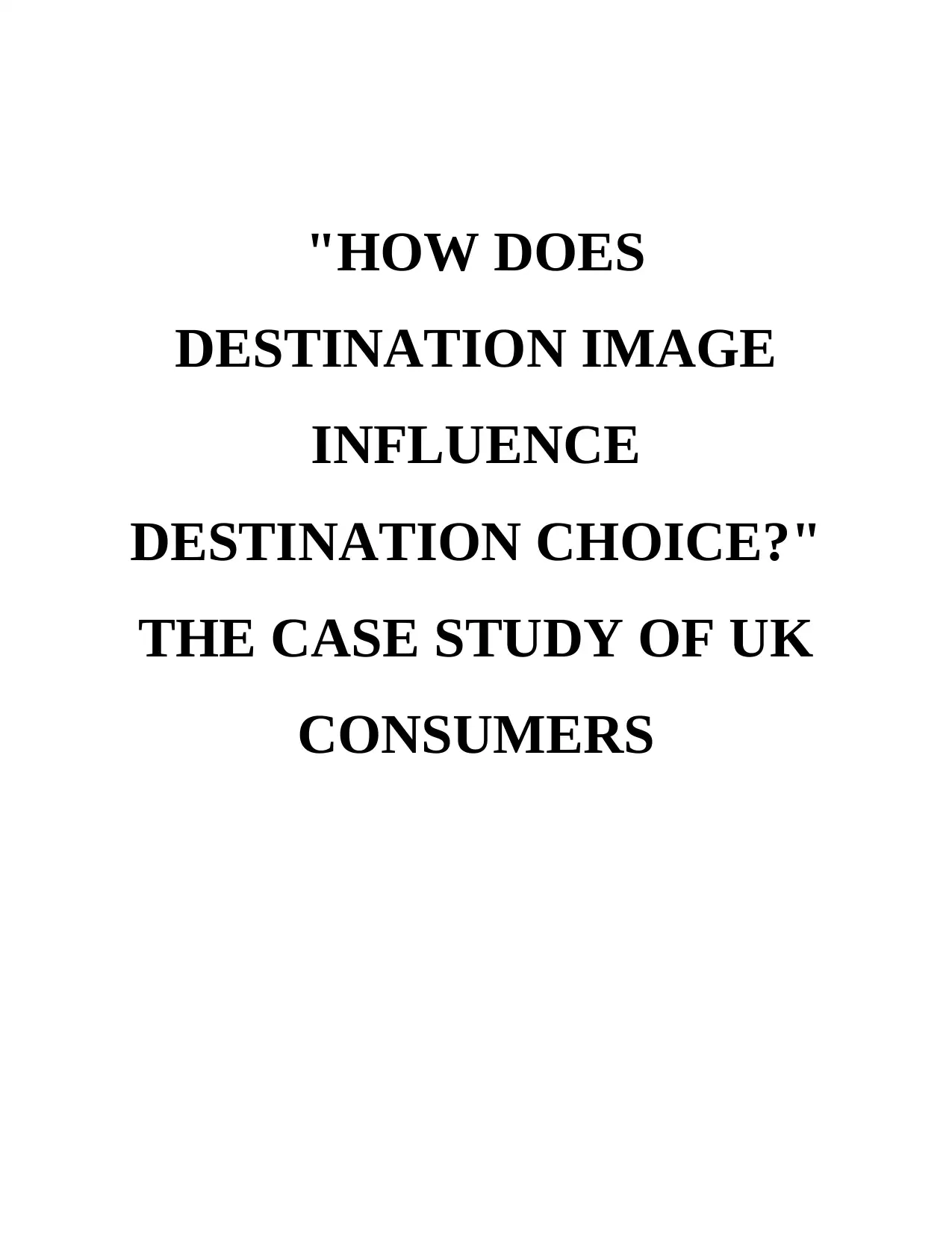
"HOW DOES
DESTINATION IMAGE
INFLUENCE
DESTINATION CHOICE?"
THE CASE STUDY OF UK
CONSUMERS
DESTINATION IMAGE
INFLUENCE
DESTINATION CHOICE?"
THE CASE STUDY OF UK
CONSUMERS
Paraphrase This Document
Need a fresh take? Get an instant paraphrase of this document with our AI Paraphraser
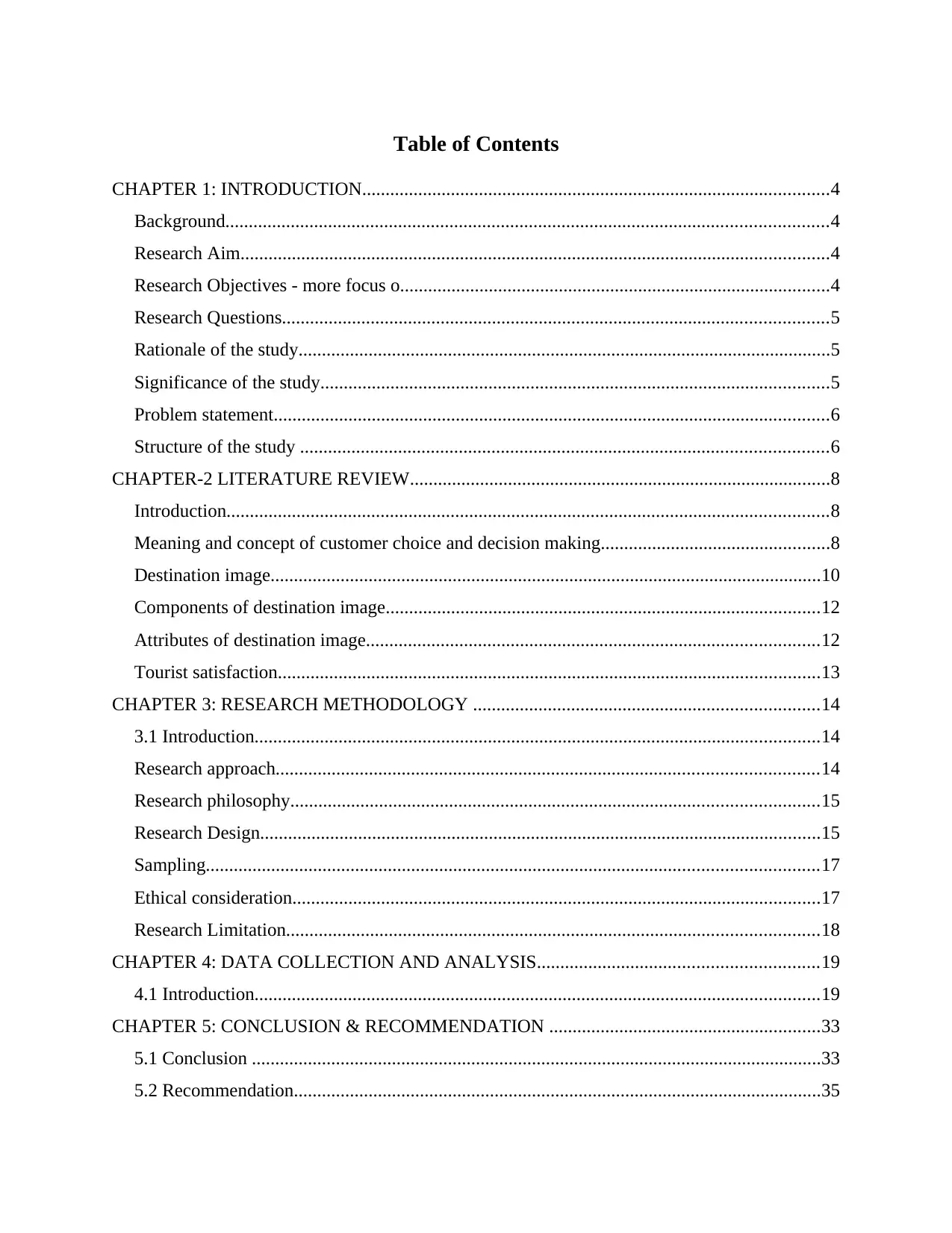
Table of Contents
CHAPTER 1: INTRODUCTION....................................................................................................4
Background.................................................................................................................................4
Research Aim..............................................................................................................................4
Research Objectives - more focus o............................................................................................4
Research Questions.....................................................................................................................5
Rationale of the study..................................................................................................................5
Significance of the study.............................................................................................................5
Problem statement.......................................................................................................................6
Structure of the study .................................................................................................................6
CHAPTER-2 LITERATURE REVIEW..........................................................................................8
Introduction.................................................................................................................................8
Meaning and concept of customer choice and decision making.................................................8
Destination image......................................................................................................................10
Components of destination image.............................................................................................12
Attributes of destination image.................................................................................................12
Tourist satisfaction....................................................................................................................13
CHAPTER 3: RESEARCH METHODOLOGY ..........................................................................14
3.1 Introduction.........................................................................................................................14
Research approach....................................................................................................................14
Research philosophy.................................................................................................................15
Research Design........................................................................................................................15
Sampling...................................................................................................................................17
Ethical consideration.................................................................................................................17
Research Limitation..................................................................................................................18
CHAPTER 4: DATA COLLECTION AND ANALYSIS............................................................19
4.1 Introduction.........................................................................................................................19
CHAPTER 5: CONCLUSION & RECOMMENDATION ..........................................................33
5.1 Conclusion ..........................................................................................................................33
5.2 Recommendation.................................................................................................................35
CHAPTER 1: INTRODUCTION....................................................................................................4
Background.................................................................................................................................4
Research Aim..............................................................................................................................4
Research Objectives - more focus o............................................................................................4
Research Questions.....................................................................................................................5
Rationale of the study..................................................................................................................5
Significance of the study.............................................................................................................5
Problem statement.......................................................................................................................6
Structure of the study .................................................................................................................6
CHAPTER-2 LITERATURE REVIEW..........................................................................................8
Introduction.................................................................................................................................8
Meaning and concept of customer choice and decision making.................................................8
Destination image......................................................................................................................10
Components of destination image.............................................................................................12
Attributes of destination image.................................................................................................12
Tourist satisfaction....................................................................................................................13
CHAPTER 3: RESEARCH METHODOLOGY ..........................................................................14
3.1 Introduction.........................................................................................................................14
Research approach....................................................................................................................14
Research philosophy.................................................................................................................15
Research Design........................................................................................................................15
Sampling...................................................................................................................................17
Ethical consideration.................................................................................................................17
Research Limitation..................................................................................................................18
CHAPTER 4: DATA COLLECTION AND ANALYSIS............................................................19
4.1 Introduction.........................................................................................................................19
CHAPTER 5: CONCLUSION & RECOMMENDATION ..........................................................33
5.1 Conclusion ..........................................................................................................................33
5.2 Recommendation.................................................................................................................35

REFERENCES.............................................................................................................................39
⊘ This is a preview!⊘
Do you want full access?
Subscribe today to unlock all pages.

Trusted by 1+ million students worldwide
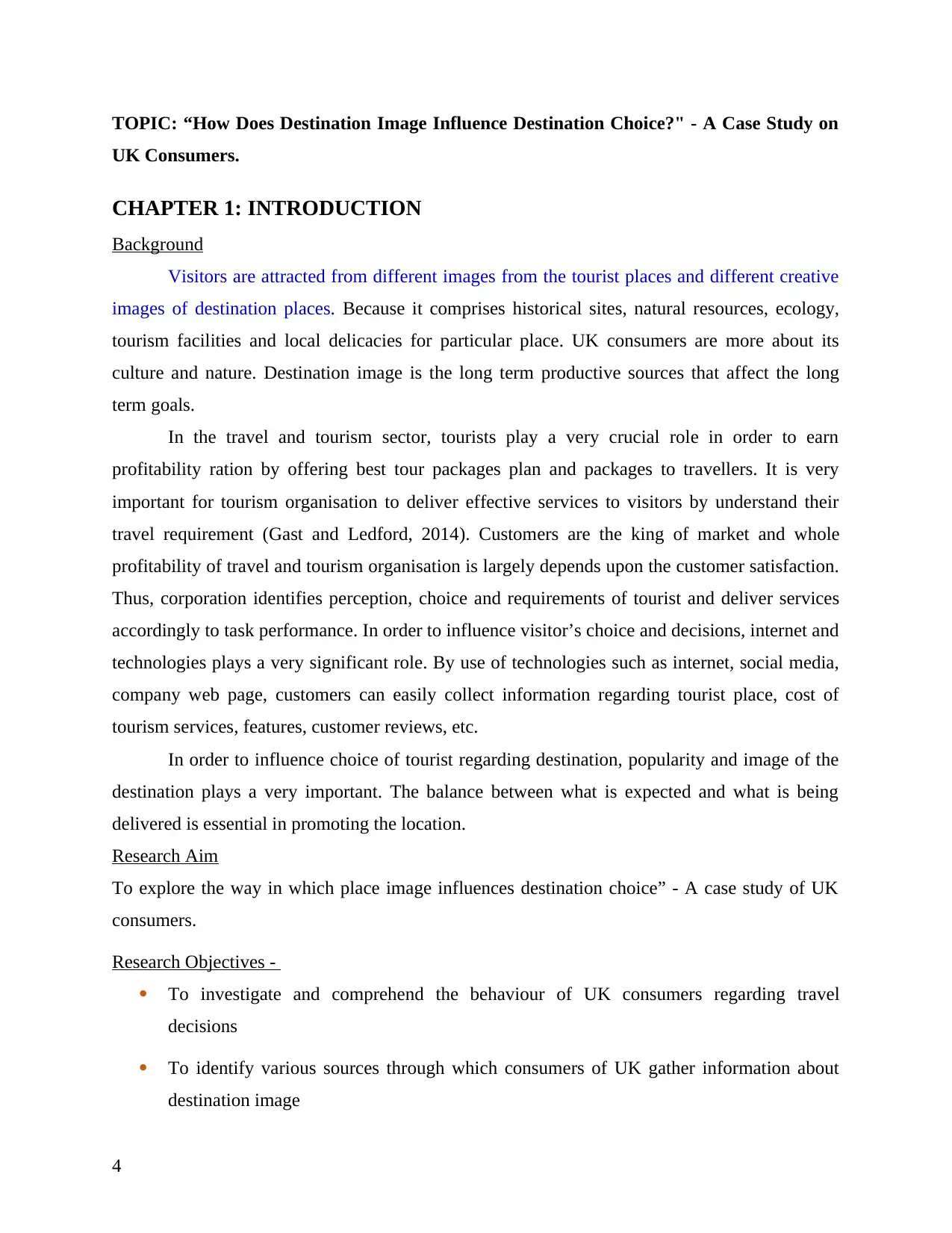
TOPIC: “How Does Destination Image Influence Destination Choice?" - A Case Study on
UK Consumers.
CHAPTER 1: INTRODUCTION
Background
Visitors are attracted from different images from the tourist places and different creative
images of destination places. Because it comprises historical sites, natural resources, ecology,
tourism facilities and local delicacies for particular place. UK consumers are more about its
culture and nature. Destination image is the long term productive sources that affect the long
term goals.
In the travel and tourism sector, tourists play a very crucial role in order to earn
profitability ration by offering best tour packages plan and packages to travellers. It is very
important for tourism organisation to deliver effective services to visitors by understand their
travel requirement (Gast and Ledford, 2014). Customers are the king of market and whole
profitability of travel and tourism organisation is largely depends upon the customer satisfaction.
Thus, corporation identifies perception, choice and requirements of tourist and deliver services
accordingly to task performance. In order to influence visitor’s choice and decisions, internet and
technologies plays a very significant role. By use of technologies such as internet, social media,
company web page, customers can easily collect information regarding tourist place, cost of
tourism services, features, customer reviews, etc.
In order to influence choice of tourist regarding destination, popularity and image of the
destination plays a very important. The balance between what is expected and what is being
delivered is essential in promoting the location.
Research Aim
To explore the way in which place image influences destination choice” - A case study of UK
consumers.
Research Objectives -
To investigate and comprehend the behaviour of UK consumers regarding travel
decisions
To identify various sources through which consumers of UK gather information about
destination image
4
UK Consumers.
CHAPTER 1: INTRODUCTION
Background
Visitors are attracted from different images from the tourist places and different creative
images of destination places. Because it comprises historical sites, natural resources, ecology,
tourism facilities and local delicacies for particular place. UK consumers are more about its
culture and nature. Destination image is the long term productive sources that affect the long
term goals.
In the travel and tourism sector, tourists play a very crucial role in order to earn
profitability ration by offering best tour packages plan and packages to travellers. It is very
important for tourism organisation to deliver effective services to visitors by understand their
travel requirement (Gast and Ledford, 2014). Customers are the king of market and whole
profitability of travel and tourism organisation is largely depends upon the customer satisfaction.
Thus, corporation identifies perception, choice and requirements of tourist and deliver services
accordingly to task performance. In order to influence visitor’s choice and decisions, internet and
technologies plays a very significant role. By use of technologies such as internet, social media,
company web page, customers can easily collect information regarding tourist place, cost of
tourism services, features, customer reviews, etc.
In order to influence choice of tourist regarding destination, popularity and image of the
destination plays a very important. The balance between what is expected and what is being
delivered is essential in promoting the location.
Research Aim
To explore the way in which place image influences destination choice” - A case study of UK
consumers.
Research Objectives -
To investigate and comprehend the behaviour of UK consumers regarding travel
decisions
To identify various sources through which consumers of UK gather information about
destination image
4
Paraphrase This Document
Need a fresh take? Get an instant paraphrase of this document with our AI Paraphraser
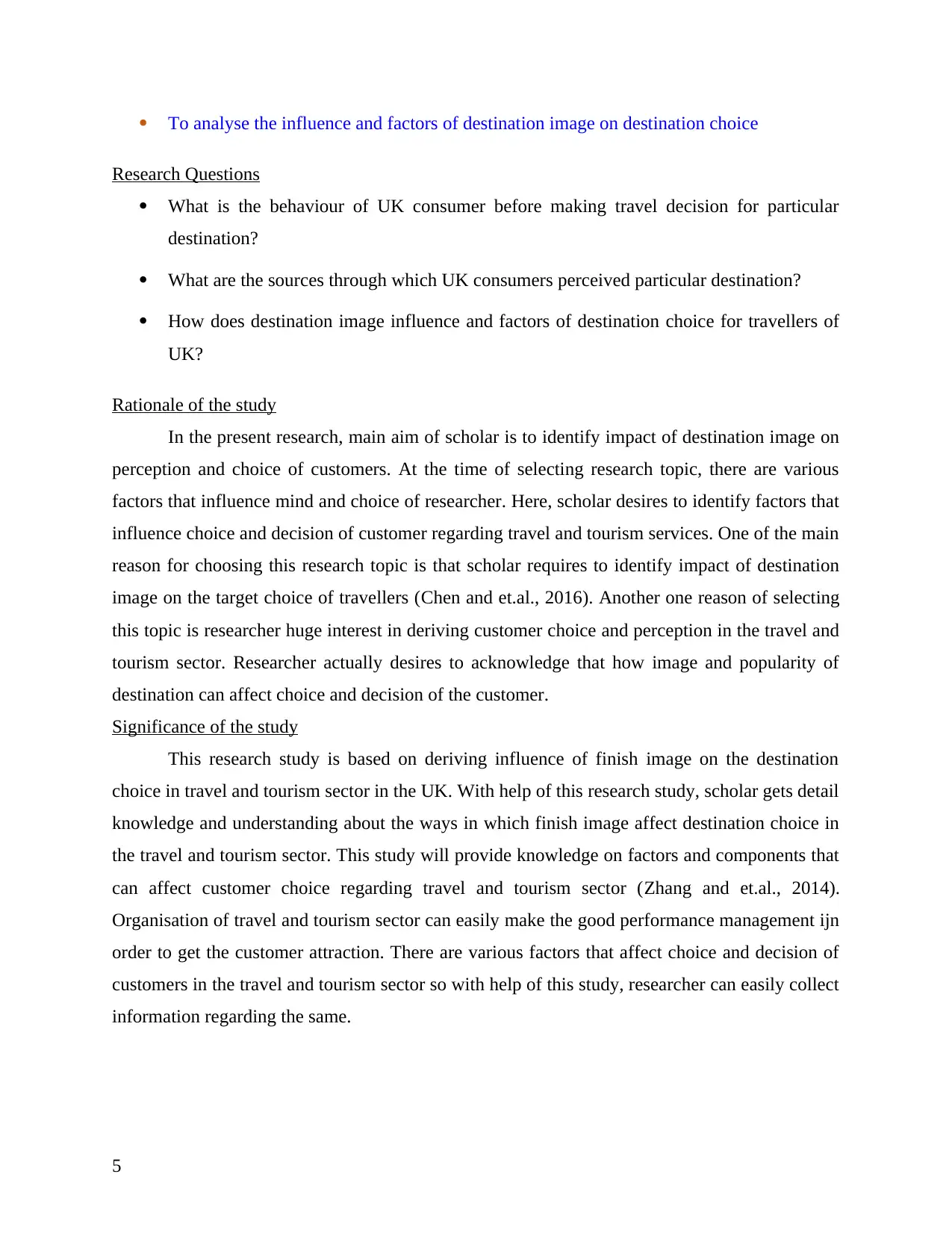
To analyse the influence and factors of destination image on destination choice
Research Questions
What is the behaviour of UK consumer before making travel decision for particular
destination?
What are the sources through which UK consumers perceived particular destination?
How does destination image influence and factors of destination choice for travellers of
UK?
Rationale of the study
In the present research, main aim of scholar is to identify impact of destination image on
perception and choice of customers. At the time of selecting research topic, there are various
factors that influence mind and choice of researcher. Here, scholar desires to identify factors that
influence choice and decision of customer regarding travel and tourism services. One of the main
reason for choosing this research topic is that scholar requires to identify impact of destination
image on the target choice of travellers (Chen and et.al., 2016). Another one reason of selecting
this topic is researcher huge interest in deriving customer choice and perception in the travel and
tourism sector. Researcher actually desires to acknowledge that how image and popularity of
destination can affect choice and decision of the customer.
Significance of the study
This research study is based on deriving influence of finish image on the destination
choice in travel and tourism sector in the UK. With help of this research study, scholar gets detail
knowledge and understanding about the ways in which finish image affect destination choice in
the travel and tourism sector. This study will provide knowledge on factors and components that
can affect customer choice regarding travel and tourism sector (Zhang and et.al., 2014).
Organisation of travel and tourism sector can easily make the good performance management ijn
order to get the customer attraction. There are various factors that affect choice and decision of
customers in the travel and tourism sector so with help of this study, researcher can easily collect
information regarding the same.
5
Research Questions
What is the behaviour of UK consumer before making travel decision for particular
destination?
What are the sources through which UK consumers perceived particular destination?
How does destination image influence and factors of destination choice for travellers of
UK?
Rationale of the study
In the present research, main aim of scholar is to identify impact of destination image on
perception and choice of customers. At the time of selecting research topic, there are various
factors that influence mind and choice of researcher. Here, scholar desires to identify factors that
influence choice and decision of customer regarding travel and tourism services. One of the main
reason for choosing this research topic is that scholar requires to identify impact of destination
image on the target choice of travellers (Chen and et.al., 2016). Another one reason of selecting
this topic is researcher huge interest in deriving customer choice and perception in the travel and
tourism sector. Researcher actually desires to acknowledge that how image and popularity of
destination can affect choice and decision of the customer.
Significance of the study
This research study is based on deriving influence of finish image on the destination
choice in travel and tourism sector in the UK. With help of this research study, scholar gets detail
knowledge and understanding about the ways in which finish image affect destination choice in
the travel and tourism sector. This study will provide knowledge on factors and components that
can affect customer choice regarding travel and tourism sector (Zhang and et.al., 2014).
Organisation of travel and tourism sector can easily make the good performance management ijn
order to get the customer attraction. There are various factors that affect choice and decision of
customers in the travel and tourism sector so with help of this study, researcher can easily collect
information regarding the same.
5
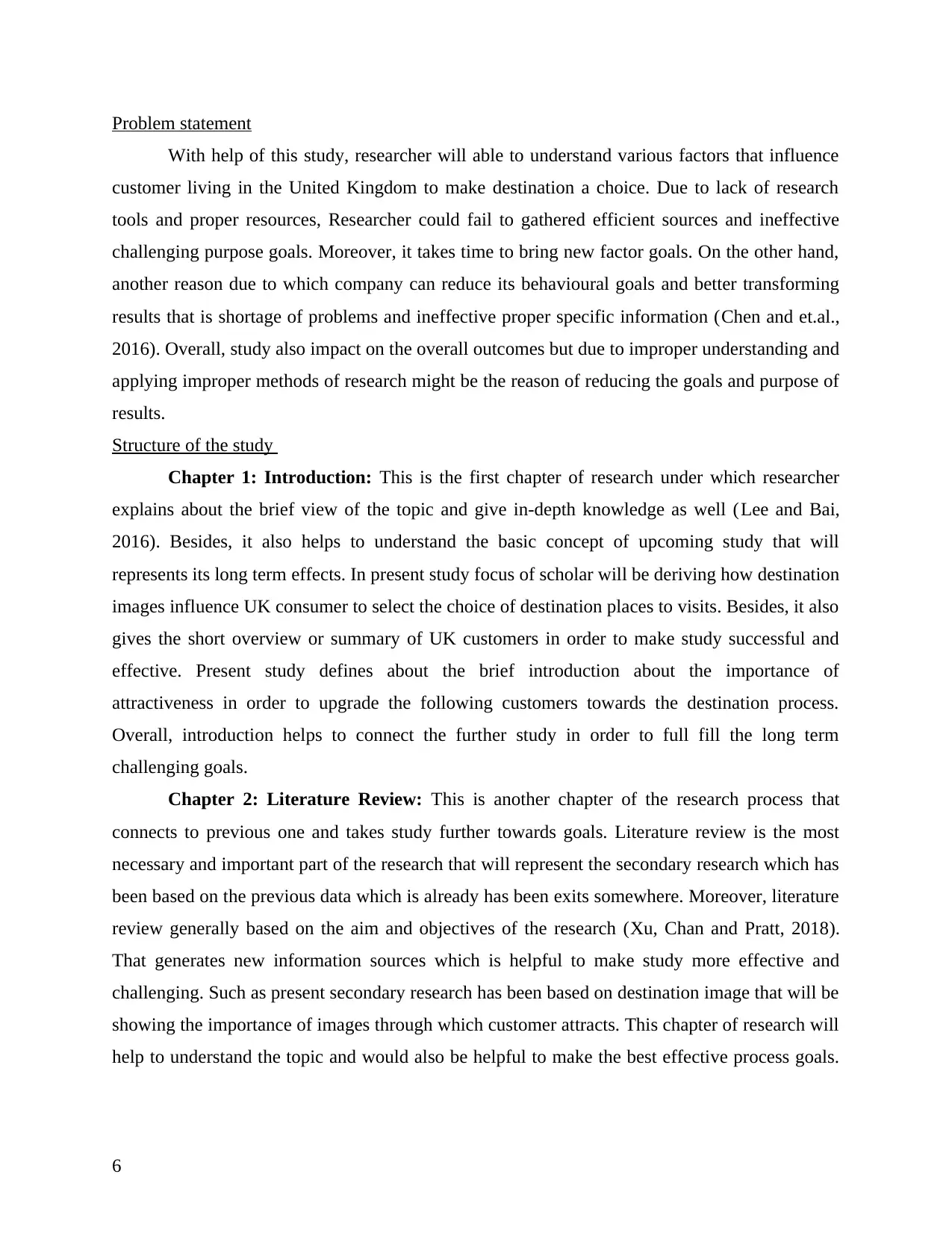
Problem statement
With help of this study, researcher will able to understand various factors that influence
customer living in the United Kingdom to make destination a choice. Due to lack of research
tools and proper resources, Researcher could fail to gathered efficient sources and ineffective
challenging purpose goals. Moreover, it takes time to bring new factor goals. On the other hand,
another reason due to which company can reduce its behavioural goals and better transforming
results that is shortage of problems and ineffective proper specific information (Chen and et.al.,
2016). Overall, study also impact on the overall outcomes but due to improper understanding and
applying improper methods of research might be the reason of reducing the goals and purpose of
results.
Structure of the study
Chapter 1: Introduction: This is the first chapter of research under which researcher
explains about the brief view of the topic and give in-depth knowledge as well (Lee and Bai,
2016). Besides, it also helps to understand the basic concept of upcoming study that will
represents its long term effects. In present study focus of scholar will be deriving how destination
images influence UK consumer to select the choice of destination places to visits. Besides, it also
gives the short overview or summary of UK customers in order to make study successful and
effective. Present study defines about the brief introduction about the importance of
attractiveness in order to upgrade the following customers towards the destination process.
Overall, introduction helps to connect the further study in order to full fill the long term
challenging goals.
Chapter 2: Literature Review: This is another chapter of the research process that
connects to previous one and takes study further towards goals. Literature review is the most
necessary and important part of the research that will represent the secondary research which has
been based on the previous data which is already has been exits somewhere. Moreover, literature
review generally based on the aim and objectives of the research (Xu, Chan and Pratt, 2018).
That generates new information sources which is helpful to make study more effective and
challenging. Such as present secondary research has been based on destination image that will be
showing the importance of images through which customer attracts. This chapter of research will
help to understand the topic and would also be helpful to make the best effective process goals.
6
With help of this study, researcher will able to understand various factors that influence
customer living in the United Kingdom to make destination a choice. Due to lack of research
tools and proper resources, Researcher could fail to gathered efficient sources and ineffective
challenging purpose goals. Moreover, it takes time to bring new factor goals. On the other hand,
another reason due to which company can reduce its behavioural goals and better transforming
results that is shortage of problems and ineffective proper specific information (Chen and et.al.,
2016). Overall, study also impact on the overall outcomes but due to improper understanding and
applying improper methods of research might be the reason of reducing the goals and purpose of
results.
Structure of the study
Chapter 1: Introduction: This is the first chapter of research under which researcher
explains about the brief view of the topic and give in-depth knowledge as well (Lee and Bai,
2016). Besides, it also helps to understand the basic concept of upcoming study that will
represents its long term effects. In present study focus of scholar will be deriving how destination
images influence UK consumer to select the choice of destination places to visits. Besides, it also
gives the short overview or summary of UK customers in order to make study successful and
effective. Present study defines about the brief introduction about the importance of
attractiveness in order to upgrade the following customers towards the destination process.
Overall, introduction helps to connect the further study in order to full fill the long term
challenging goals.
Chapter 2: Literature Review: This is another chapter of the research process that
connects to previous one and takes study further towards goals. Literature review is the most
necessary and important part of the research that will represent the secondary research which has
been based on the previous data which is already has been exits somewhere. Moreover, literature
review generally based on the aim and objectives of the research (Xu, Chan and Pratt, 2018).
That generates new information sources which is helpful to make study more effective and
challenging. Such as present secondary research has been based on destination image that will be
showing the importance of images through which customer attracts. This chapter of research will
help to understand the topic and would also be helpful to make the best effective process goals.
6
⊘ This is a preview!⊘
Do you want full access?
Subscribe today to unlock all pages.

Trusted by 1+ million students worldwide
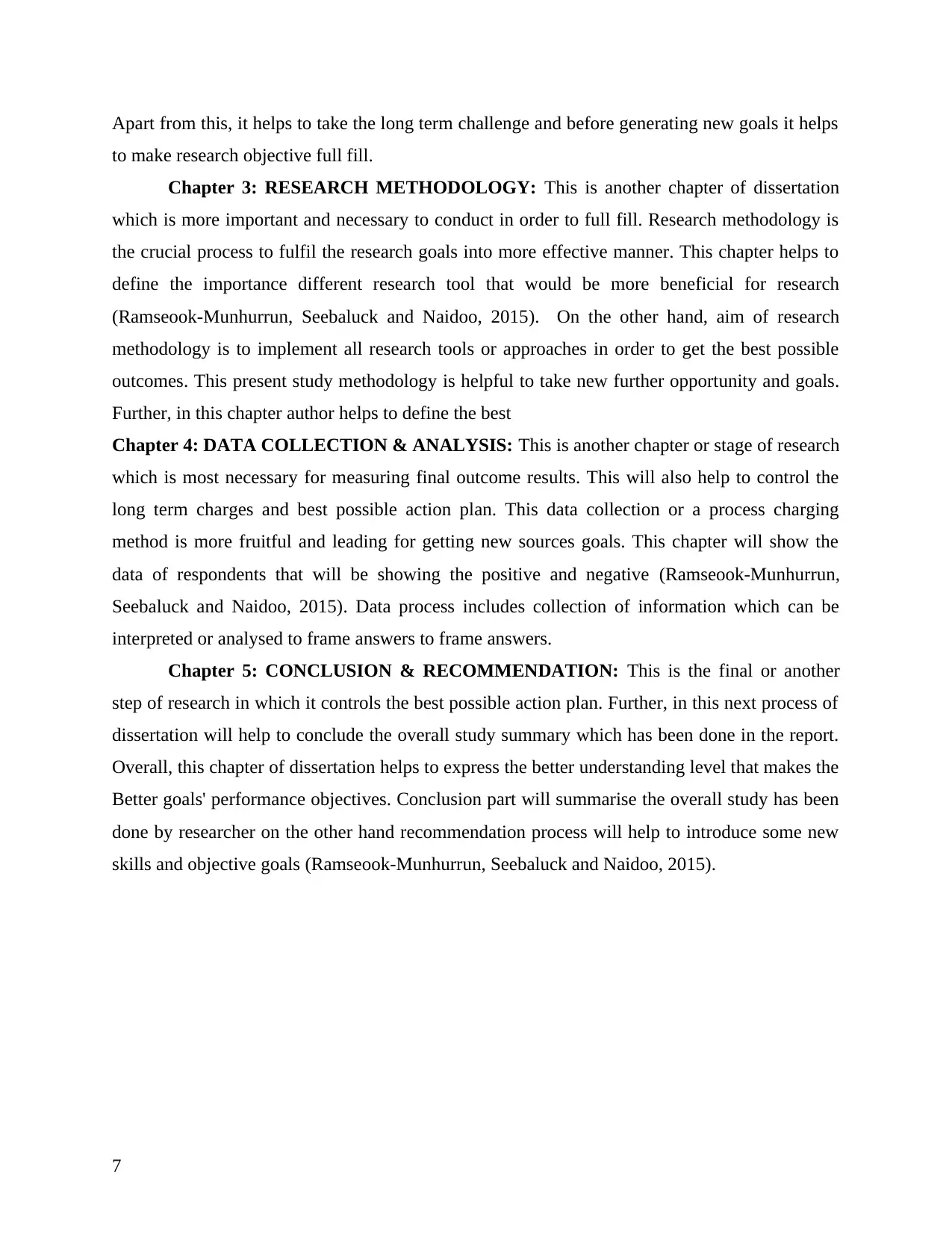
Apart from this, it helps to take the long term challenge and before generating new goals it helps
to make research objective full fill.
Chapter 3: RESEARCH METHODOLOGY: This is another chapter of dissertation
which is more important and necessary to conduct in order to full fill. Research methodology is
the crucial process to fulfil the research goals into more effective manner. This chapter helps to
define the importance different research tool that would be more beneficial for research
(Ramseook-Munhurrun, Seebaluck and Naidoo, 2015). On the other hand, aim of research
methodology is to implement all research tools or approaches in order to get the best possible
outcomes. This present study methodology is helpful to take new further opportunity and goals.
Further, in this chapter author helps to define the best
Chapter 4: DATA COLLECTION & ANALYSIS: This is another chapter or stage of research
which is most necessary for measuring final outcome results. This will also help to control the
long term charges and best possible action plan. This data collection or a process charging
method is more fruitful and leading for getting new sources goals. This chapter will show the
data of respondents that will be showing the positive and negative (Ramseook-Munhurrun,
Seebaluck and Naidoo, 2015). Data process includes collection of information which can be
interpreted or analysed to frame answers to frame answers.
Chapter 5: CONCLUSION & RECOMMENDATION: This is the final or another
step of research in which it controls the best possible action plan. Further, in this next process of
dissertation will help to conclude the overall study summary which has been done in the report.
Overall, this chapter of dissertation helps to express the better understanding level that makes the
Better goals' performance objectives. Conclusion part will summarise the overall study has been
done by researcher on the other hand recommendation process will help to introduce some new
skills and objective goals (Ramseook-Munhurrun, Seebaluck and Naidoo, 2015).
7
to make research objective full fill.
Chapter 3: RESEARCH METHODOLOGY: This is another chapter of dissertation
which is more important and necessary to conduct in order to full fill. Research methodology is
the crucial process to fulfil the research goals into more effective manner. This chapter helps to
define the importance different research tool that would be more beneficial for research
(Ramseook-Munhurrun, Seebaluck and Naidoo, 2015). On the other hand, aim of research
methodology is to implement all research tools or approaches in order to get the best possible
outcomes. This present study methodology is helpful to take new further opportunity and goals.
Further, in this chapter author helps to define the best
Chapter 4: DATA COLLECTION & ANALYSIS: This is another chapter or stage of research
which is most necessary for measuring final outcome results. This will also help to control the
long term charges and best possible action plan. This data collection or a process charging
method is more fruitful and leading for getting new sources goals. This chapter will show the
data of respondents that will be showing the positive and negative (Ramseook-Munhurrun,
Seebaluck and Naidoo, 2015). Data process includes collection of information which can be
interpreted or analysed to frame answers to frame answers.
Chapter 5: CONCLUSION & RECOMMENDATION: This is the final or another
step of research in which it controls the best possible action plan. Further, in this next process of
dissertation will help to conclude the overall study summary which has been done in the report.
Overall, this chapter of dissertation helps to express the better understanding level that makes the
Better goals' performance objectives. Conclusion part will summarise the overall study has been
done by researcher on the other hand recommendation process will help to introduce some new
skills and objective goals (Ramseook-Munhurrun, Seebaluck and Naidoo, 2015).
7
Paraphrase This Document
Need a fresh take? Get an instant paraphrase of this document with our AI Paraphraser
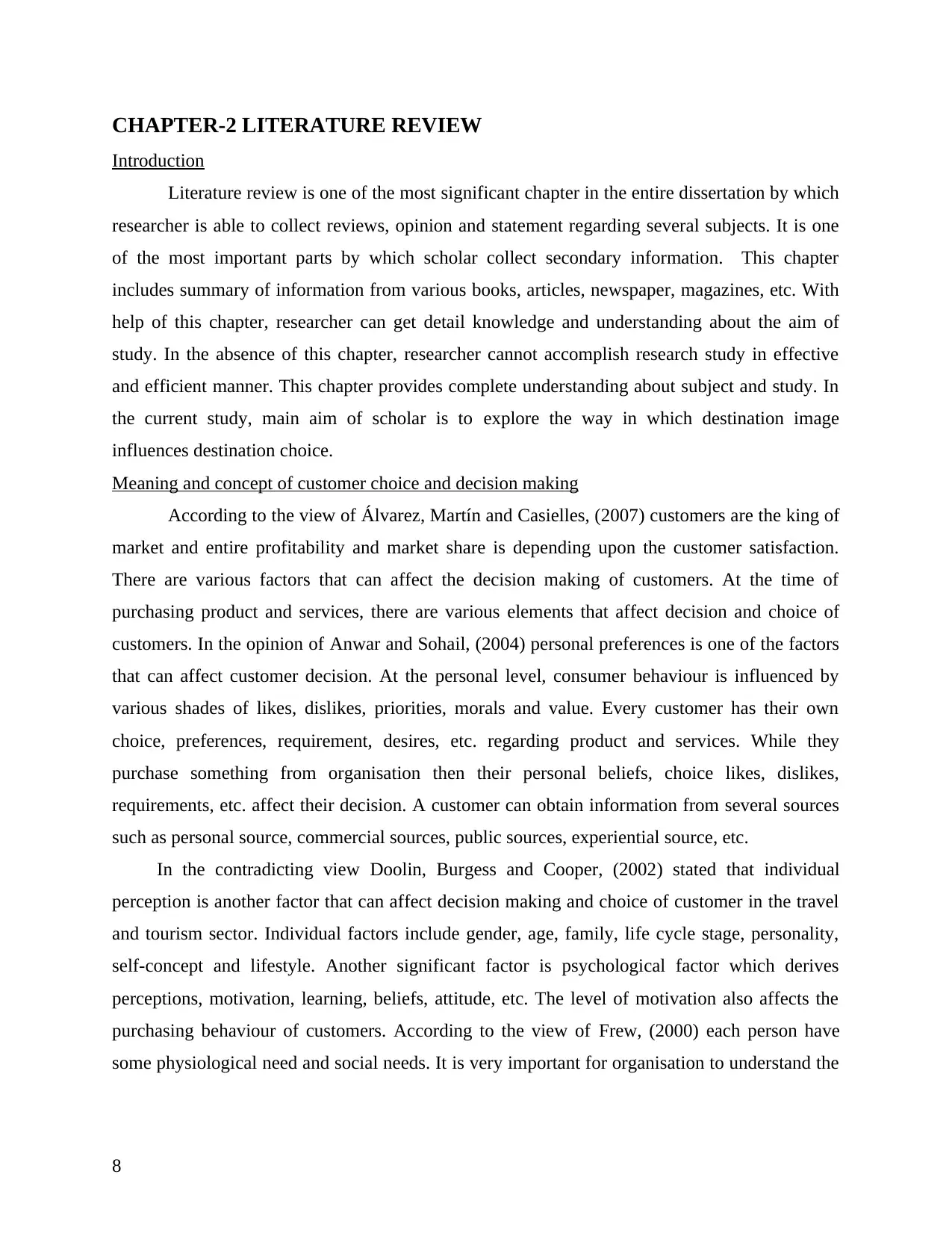
CHAPTER-2 LITERATURE REVIEW
Introduction
Literature review is one of the most significant chapter in the entire dissertation by which
researcher is able to collect reviews, opinion and statement regarding several subjects. It is one
of the most important parts by which scholar collect secondary information. This chapter
includes summary of information from various books, articles, newspaper, magazines, etc. With
help of this chapter, researcher can get detail knowledge and understanding about the aim of
study. In the absence of this chapter, researcher cannot accomplish research study in effective
and efficient manner. This chapter provides complete understanding about subject and study. In
the current study, main aim of scholar is to explore the way in which destination image
influences destination choice.
Meaning and concept of customer choice and decision making
According to the view of Álvarez, Martín and Casielles, (2007) customers are the king of
market and entire profitability and market share is depending upon the customer satisfaction.
There are various factors that can affect the decision making of customers. At the time of
purchasing product and services, there are various elements that affect decision and choice of
customers. In the opinion of Anwar and Sohail, (2004) personal preferences is one of the factors
that can affect customer decision. At the personal level, consumer behaviour is influenced by
various shades of likes, dislikes, priorities, morals and value. Every customer has their own
choice, preferences, requirement, desires, etc. regarding product and services. While they
purchase something from organisation then their personal beliefs, choice likes, dislikes,
requirements, etc. affect their decision. A customer can obtain information from several sources
such as personal source, commercial sources, public sources, experiential source, etc.
In the contradicting view Doolin, Burgess and Cooper, (2002) stated that individual
perception is another factor that can affect decision making and choice of customer in the travel
and tourism sector. Individual factors include gender, age, family, life cycle stage, personality,
self-concept and lifestyle. Another significant factor is psychological factor which derives
perceptions, motivation, learning, beliefs, attitude, etc. The level of motivation also affects the
purchasing behaviour of customers. According to the view of Frew, (2000) each person have
some physiological need and social needs. It is very important for organisation to understand the
8
Introduction
Literature review is one of the most significant chapter in the entire dissertation by which
researcher is able to collect reviews, opinion and statement regarding several subjects. It is one
of the most important parts by which scholar collect secondary information. This chapter
includes summary of information from various books, articles, newspaper, magazines, etc. With
help of this chapter, researcher can get detail knowledge and understanding about the aim of
study. In the absence of this chapter, researcher cannot accomplish research study in effective
and efficient manner. This chapter provides complete understanding about subject and study. In
the current study, main aim of scholar is to explore the way in which destination image
influences destination choice.
Meaning and concept of customer choice and decision making
According to the view of Álvarez, Martín and Casielles, (2007) customers are the king of
market and entire profitability and market share is depending upon the customer satisfaction.
There are various factors that can affect the decision making of customers. At the time of
purchasing product and services, there are various elements that affect decision and choice of
customers. In the opinion of Anwar and Sohail, (2004) personal preferences is one of the factors
that can affect customer decision. At the personal level, consumer behaviour is influenced by
various shades of likes, dislikes, priorities, morals and value. Every customer has their own
choice, preferences, requirement, desires, etc. regarding product and services. While they
purchase something from organisation then their personal beliefs, choice likes, dislikes,
requirements, etc. affect their decision. A customer can obtain information from several sources
such as personal source, commercial sources, public sources, experiential source, etc.
In the contradicting view Doolin, Burgess and Cooper, (2002) stated that individual
perception is another factor that can affect decision making and choice of customer in the travel
and tourism sector. Individual factors include gender, age, family, life cycle stage, personality,
self-concept and lifestyle. Another significant factor is psychological factor which derives
perceptions, motivation, learning, beliefs, attitude, etc. The level of motivation also affects the
purchasing behaviour of customers. According to the view of Frew, (2000) each person have
some physiological need and social needs. It is very important for organisation to understand the
8
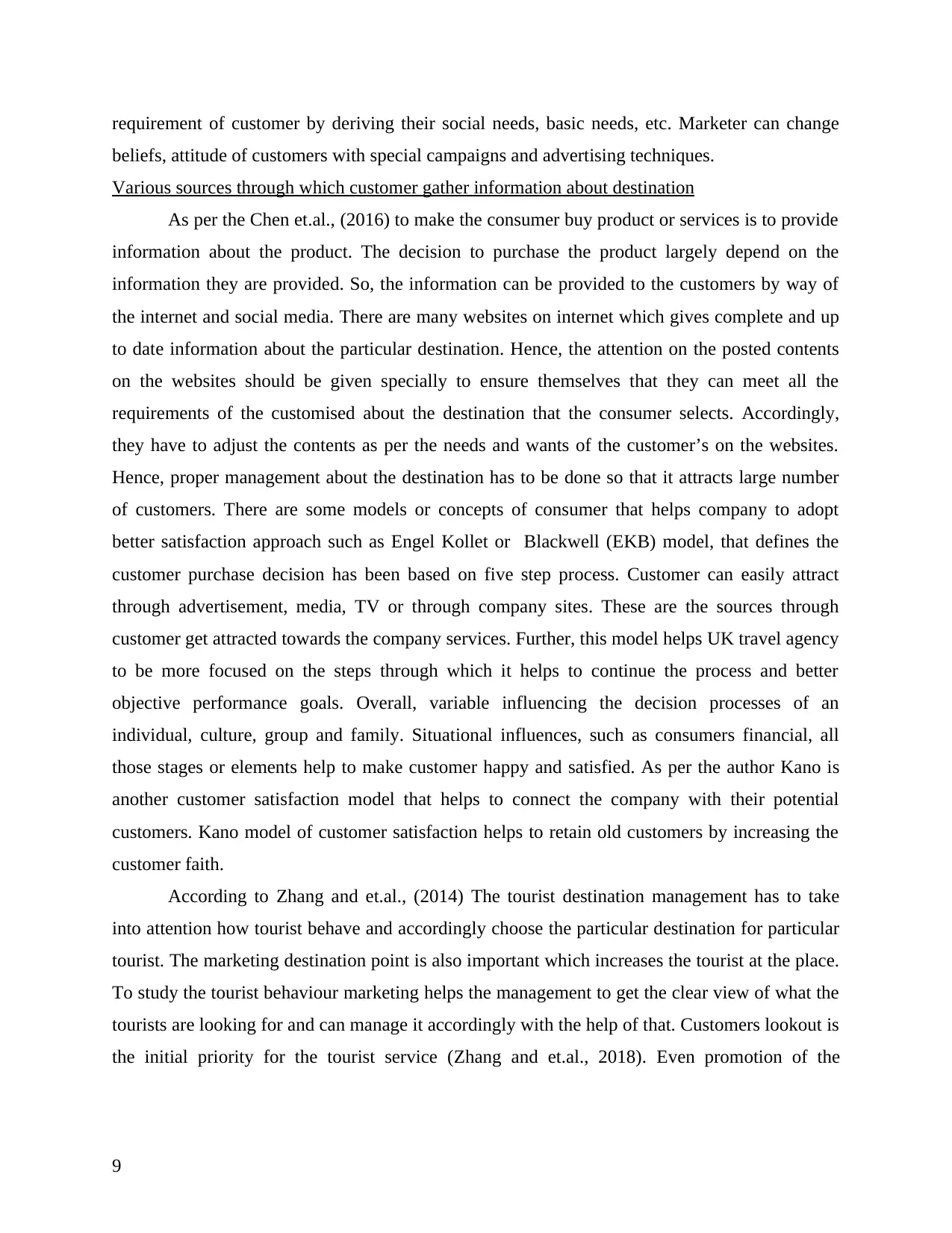
requirement of customer by deriving their social needs, basic needs, etc. Marketer can change
beliefs, attitude of customers with special campaigns and advertising techniques.
Various sources through which customer gather information about destination
As per the Chen et.al., (2016) to make the consumer buy product or services is to provide
information about the product. The decision to purchase the product largely depend on the
information they are provided. So, the information can be provided to the customers by way of
the internet and social media. There are many websites on internet which gives complete and up
to date information about the particular destination. Hence, the attention on the posted contents
on the websites should be given specially to ensure themselves that they can meet all the
requirements of the customised about the destination that the consumer selects. Accordingly,
they have to adjust the contents as per the needs and wants of the customer’s on the websites.
Hence, proper management about the destination has to be done so that it attracts large number
of customers. There are some models or concepts of consumer that helps company to adopt
better satisfaction approach such as Engel Kollet or Blackwell (EKB) model, that defines the
customer purchase decision has been based on five step process. Customer can easily attract
through advertisement, media, TV or through company sites. These are the sources through
customer get attracted towards the company services. Further, this model helps UK travel agency
to be more focused on the steps through which it helps to continue the process and better
objective performance goals. Overall, variable influencing the decision processes of an
individual, culture, group and family. Situational influences, such as consumers financial, all
those stages or elements help to make customer happy and satisfied. As per the author Kano is
another customer satisfaction model that helps to connect the company with their potential
customers. Kano model of customer satisfaction helps to retain old customers by increasing the
customer faith.
According to Zhang and et.al., (2014) The tourist destination management has to take
into attention how tourist behave and accordingly choose the particular destination for particular
tourist. The marketing destination point is also important which increases the tourist at the place.
To study the tourist behaviour marketing helps the management to get the clear view of what the
tourists are looking for and can manage it accordingly with the help of that. Customers lookout is
the initial priority for the tourist service (Zhang and et.al., 2018). Even promotion of the
9
beliefs, attitude of customers with special campaigns and advertising techniques.
Various sources through which customer gather information about destination
As per the Chen et.al., (2016) to make the consumer buy product or services is to provide
information about the product. The decision to purchase the product largely depend on the
information they are provided. So, the information can be provided to the customers by way of
the internet and social media. There are many websites on internet which gives complete and up
to date information about the particular destination. Hence, the attention on the posted contents
on the websites should be given specially to ensure themselves that they can meet all the
requirements of the customised about the destination that the consumer selects. Accordingly,
they have to adjust the contents as per the needs and wants of the customer’s on the websites.
Hence, proper management about the destination has to be done so that it attracts large number
of customers. There are some models or concepts of consumer that helps company to adopt
better satisfaction approach such as Engel Kollet or Blackwell (EKB) model, that defines the
customer purchase decision has been based on five step process. Customer can easily attract
through advertisement, media, TV or through company sites. These are the sources through
customer get attracted towards the company services. Further, this model helps UK travel agency
to be more focused on the steps through which it helps to continue the process and better
objective performance goals. Overall, variable influencing the decision processes of an
individual, culture, group and family. Situational influences, such as consumers financial, all
those stages or elements help to make customer happy and satisfied. As per the author Kano is
another customer satisfaction model that helps to connect the company with their potential
customers. Kano model of customer satisfaction helps to retain old customers by increasing the
customer faith.
According to Zhang and et.al., (2014) The tourist destination management has to take
into attention how tourist behave and accordingly choose the particular destination for particular
tourist. The marketing destination point is also important which increases the tourist at the place.
To study the tourist behaviour marketing helps the management to get the clear view of what the
tourists are looking for and can manage it accordingly with the help of that. Customers lookout is
the initial priority for the tourist service (Zhang and et.al., 2018). Even promotion of the
9
⊘ This is a preview!⊘
Do you want full access?
Subscribe today to unlock all pages.

Trusted by 1+ million students worldwide
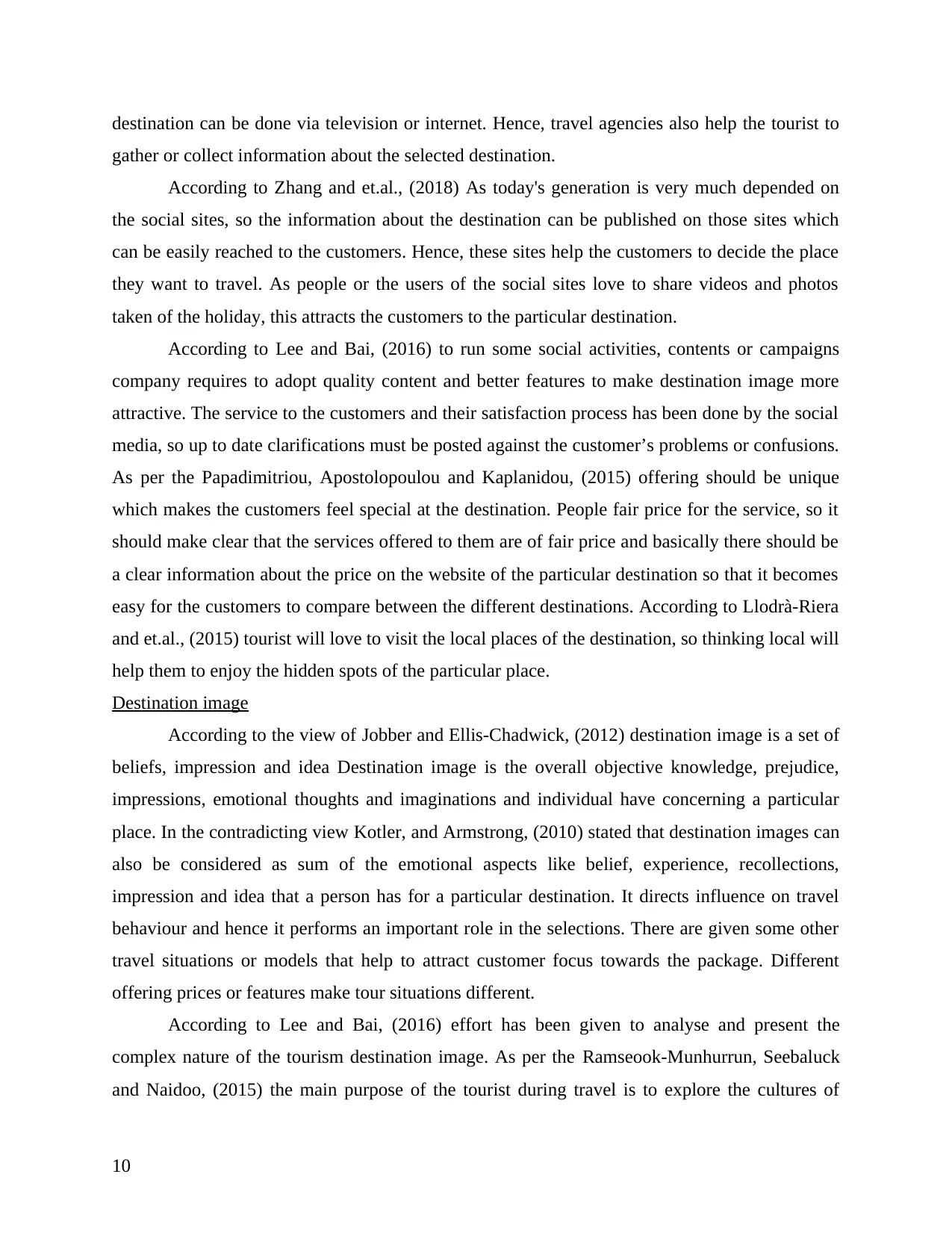
destination can be done via television or internet. Hence, travel agencies also help the tourist to
gather or collect information about the selected destination.
According to Zhang and et.al., (2018) As today's generation is very much depended on
the social sites, so the information about the destination can be published on those sites which
can be easily reached to the customers. Hence, these sites help the customers to decide the place
they want to travel. As people or the users of the social sites love to share videos and photos
taken of the holiday, this attracts the customers to the particular destination.
According to Lee and Bai, (2016) to run some social activities, contents or campaigns
company requires to adopt quality content and better features to make destination image more
attractive. The service to the customers and their satisfaction process has been done by the social
media, so up to date clarifications must be posted against the customer’s problems or confusions.
As per the Papadimitriou, Apostolopoulou and Kaplanidou, (2015) offering should be unique
which makes the customers feel special at the destination. People fair price for the service, so it
should make clear that the services offered to them are of fair price and basically there should be
a clear information about the price on the website of the particular destination so that it becomes
easy for the customers to compare between the different destinations. According to Llodrà-Riera
and et.al., (2015) tourist will love to visit the local places of the destination, so thinking local will
help them to enjoy the hidden spots of the particular place.
Destination image
According to the view of Jobber and Ellis-Chadwick, (2012) destination image is a set of
beliefs, impression and idea Destination image is the overall objective knowledge, prejudice,
impressions, emotional thoughts and imaginations and individual have concerning a particular
place. In the contradicting view Kotler, and Armstrong, (2010) stated that destination images can
also be considered as sum of the emotional aspects like belief, experience, recollections,
impression and idea that a person has for a particular destination. It directs influence on travel
behaviour and hence it performs an important role in the selections. There are given some other
travel situations or models that help to attract customer focus towards the package. Different
offering prices or features make tour situations different.
According to Lee and Bai, (2016) effort has been given to analyse and present the
complex nature of the tourism destination image. As per the Ramseook-Munhurrun, Seebaluck
and Naidoo, (2015) the main purpose of the tourist during travel is to explore the cultures of
10
gather or collect information about the selected destination.
According to Zhang and et.al., (2018) As today's generation is very much depended on
the social sites, so the information about the destination can be published on those sites which
can be easily reached to the customers. Hence, these sites help the customers to decide the place
they want to travel. As people or the users of the social sites love to share videos and photos
taken of the holiday, this attracts the customers to the particular destination.
According to Lee and Bai, (2016) to run some social activities, contents or campaigns
company requires to adopt quality content and better features to make destination image more
attractive. The service to the customers and their satisfaction process has been done by the social
media, so up to date clarifications must be posted against the customer’s problems or confusions.
As per the Papadimitriou, Apostolopoulou and Kaplanidou, (2015) offering should be unique
which makes the customers feel special at the destination. People fair price for the service, so it
should make clear that the services offered to them are of fair price and basically there should be
a clear information about the price on the website of the particular destination so that it becomes
easy for the customers to compare between the different destinations. According to Llodrà-Riera
and et.al., (2015) tourist will love to visit the local places of the destination, so thinking local will
help them to enjoy the hidden spots of the particular place.
Destination image
According to the view of Jobber and Ellis-Chadwick, (2012) destination image is a set of
beliefs, impression and idea Destination image is the overall objective knowledge, prejudice,
impressions, emotional thoughts and imaginations and individual have concerning a particular
place. In the contradicting view Kotler, and Armstrong, (2010) stated that destination images can
also be considered as sum of the emotional aspects like belief, experience, recollections,
impression and idea that a person has for a particular destination. It directs influence on travel
behaviour and hence it performs an important role in the selections. There are given some other
travel situations or models that help to attract customer focus towards the package. Different
offering prices or features make tour situations different.
According to Lee and Bai, (2016) effort has been given to analyse and present the
complex nature of the tourism destination image. As per the Ramseook-Munhurrun, Seebaluck
and Naidoo, (2015) the main purpose of the tourist during travel is to explore the cultures of
10
Paraphrase This Document
Need a fresh take? Get an instant paraphrase of this document with our AI Paraphraser
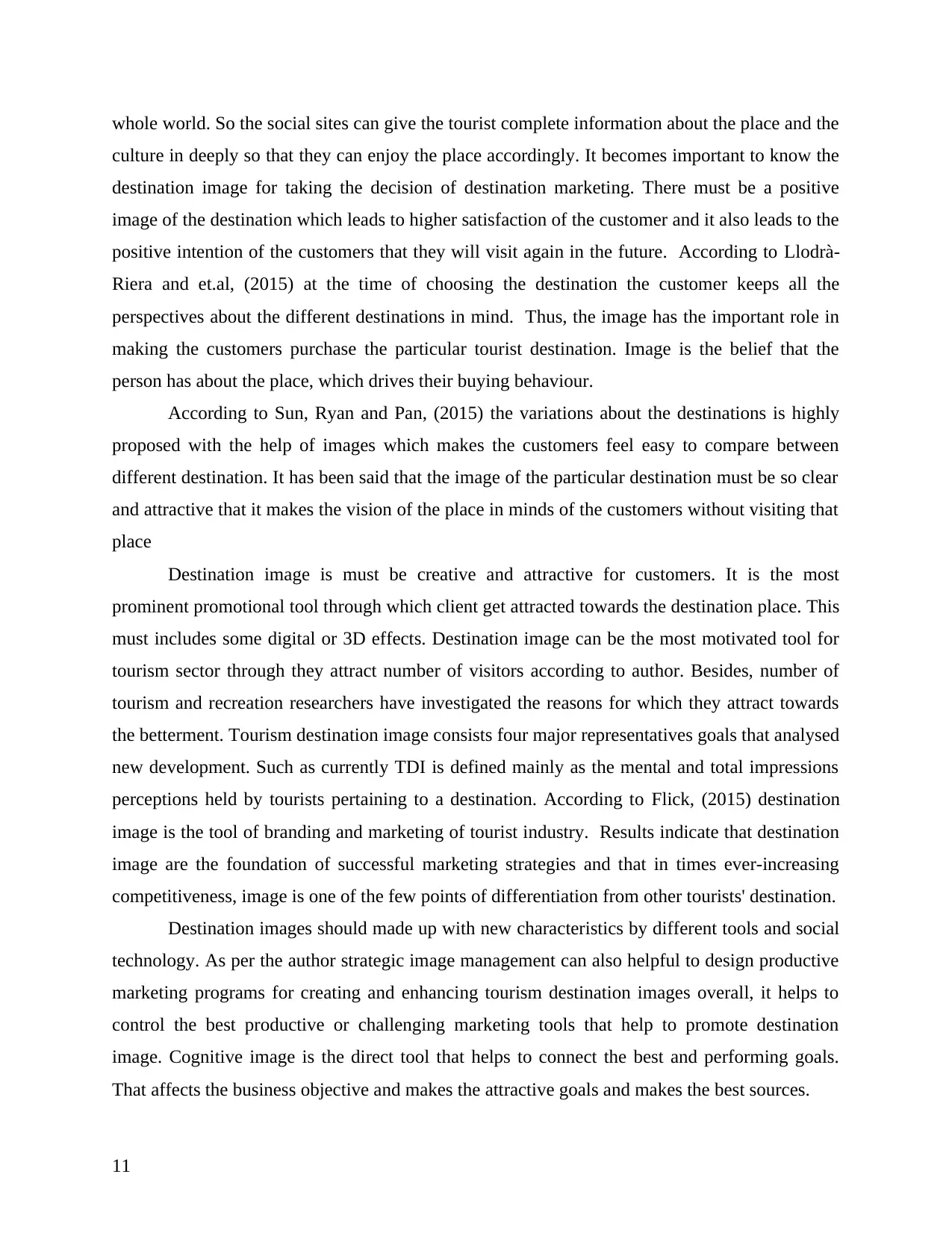
whole world. So the social sites can give the tourist complete information about the place and the
culture in deeply so that they can enjoy the place accordingly. It becomes important to know the
destination image for taking the decision of destination marketing. There must be a positive
image of the destination which leads to higher satisfaction of the customer and it also leads to the
positive intention of the customers that they will visit again in the future. According to Llodrà-
Riera and et.al, (2015) at the time of choosing the destination the customer keeps all the
perspectives about the different destinations in mind. Thus, the image has the important role in
making the customers purchase the particular tourist destination. Image is the belief that the
person has about the place, which drives their buying behaviour.
According to Sun, Ryan and Pan, (2015) the variations about the destinations is highly
proposed with the help of images which makes the customers feel easy to compare between
different destination. It has been said that the image of the particular destination must be so clear
and attractive that it makes the vision of the place in minds of the customers without visiting that
place
Destination image is must be creative and attractive for customers. It is the most
prominent promotional tool through which client get attracted towards the destination place. This
must includes some digital or 3D effects. Destination image can be the most motivated tool for
tourism sector through they attract number of visitors according to author. Besides, number of
tourism and recreation researchers have investigated the reasons for which they attract towards
the betterment. Tourism destination image consists four major representatives goals that analysed
new development. Such as currently TDI is defined mainly as the mental and total impressions
perceptions held by tourists pertaining to a destination. According to Flick, (2015) destination
image is the tool of branding and marketing of tourist industry. Results indicate that destination
image are the foundation of successful marketing strategies and that in times ever-increasing
competitiveness, image is one of the few points of differentiation from other tourists' destination.
Destination images should made up with new characteristics by different tools and social
technology. As per the author strategic image management can also helpful to design productive
marketing programs for creating and enhancing tourism destination images overall, it helps to
control the best productive or challenging marketing tools that help to promote destination
image. Cognitive image is the direct tool that helps to connect the best and performing goals.
That affects the business objective and makes the attractive goals and makes the best sources.
11
culture in deeply so that they can enjoy the place accordingly. It becomes important to know the
destination image for taking the decision of destination marketing. There must be a positive
image of the destination which leads to higher satisfaction of the customer and it also leads to the
positive intention of the customers that they will visit again in the future. According to Llodrà-
Riera and et.al, (2015) at the time of choosing the destination the customer keeps all the
perspectives about the different destinations in mind. Thus, the image has the important role in
making the customers purchase the particular tourist destination. Image is the belief that the
person has about the place, which drives their buying behaviour.
According to Sun, Ryan and Pan, (2015) the variations about the destinations is highly
proposed with the help of images which makes the customers feel easy to compare between
different destination. It has been said that the image of the particular destination must be so clear
and attractive that it makes the vision of the place in minds of the customers without visiting that
place
Destination image is must be creative and attractive for customers. It is the most
prominent promotional tool through which client get attracted towards the destination place. This
must includes some digital or 3D effects. Destination image can be the most motivated tool for
tourism sector through they attract number of visitors according to author. Besides, number of
tourism and recreation researchers have investigated the reasons for which they attract towards
the betterment. Tourism destination image consists four major representatives goals that analysed
new development. Such as currently TDI is defined mainly as the mental and total impressions
perceptions held by tourists pertaining to a destination. According to Flick, (2015) destination
image is the tool of branding and marketing of tourist industry. Results indicate that destination
image are the foundation of successful marketing strategies and that in times ever-increasing
competitiveness, image is one of the few points of differentiation from other tourists' destination.
Destination images should made up with new characteristics by different tools and social
technology. As per the author strategic image management can also helpful to design productive
marketing programs for creating and enhancing tourism destination images overall, it helps to
control the best productive or challenging marketing tools that help to promote destination
image. Cognitive image is the direct tool that helps to connect the best and performing goals.
That affects the business objective and makes the attractive goals and makes the best sources.
11
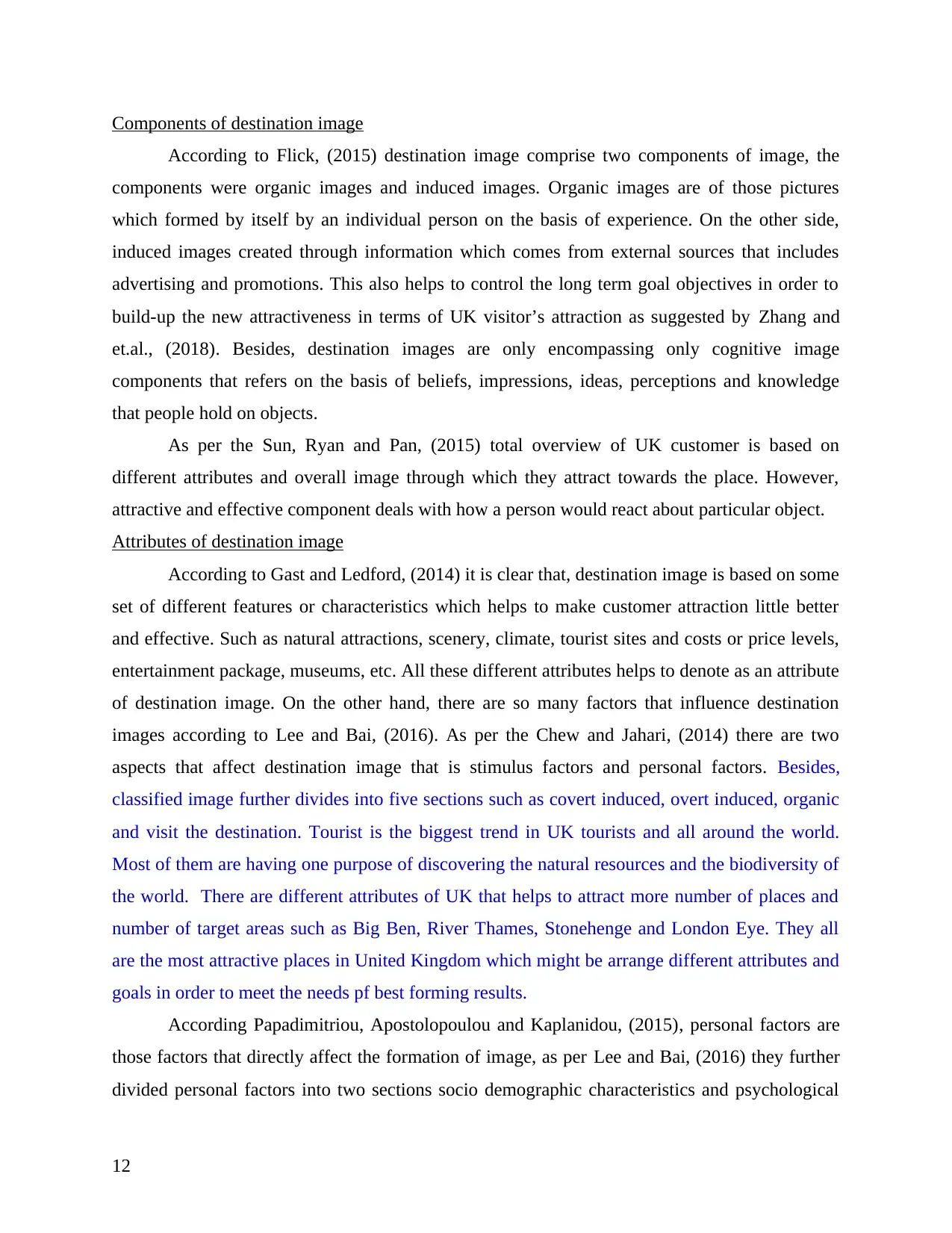
Components of destination image
According to Flick, (2015) destination image comprise two components of image, the
components were organic images and induced images. Organic images are of those pictures
which formed by itself by an individual person on the basis of experience. On the other side,
induced images created through information which comes from external sources that includes
advertising and promotions. This also helps to control the long term goal objectives in order to
build-up the new attractiveness in terms of UK visitor’s attraction as suggested by Zhang and
et.al., (2018). Besides, destination images are only encompassing only cognitive image
components that refers on the basis of beliefs, impressions, ideas, perceptions and knowledge
that people hold on objects.
As per the Sun, Ryan and Pan, (2015) total overview of UK customer is based on
different attributes and overall image through which they attract towards the place. However,
attractive and effective component deals with how a person would react about particular object.
Attributes of destination image
According to Gast and Ledford, (2014) it is clear that, destination image is based on some
set of different features or characteristics which helps to make customer attraction little better
and effective. Such as natural attractions, scenery, climate, tourist sites and costs or price levels,
entertainment package, museums, etc. All these different attributes helps to denote as an attribute
of destination image. On the other hand, there are so many factors that influence destination
images according to Lee and Bai, (2016). As per the Chew and Jahari, (2014) there are two
aspects that affect destination image that is stimulus factors and personal factors. Besides,
classified image further divides into five sections such as covert induced, overt induced, organic
and visit the destination. Tourist is the biggest trend in UK tourists and all around the world.
Most of them are having one purpose of discovering the natural resources and the biodiversity of
the world. There are different attributes of UK that helps to attract more number of places and
number of target areas such as Big Ben, River Thames, Stonehenge and London Eye. They all
are the most attractive places in United Kingdom which might be arrange different attributes and
goals in order to meet the needs pf best forming results.
According Papadimitriou, Apostolopoulou and Kaplanidou, (2015), personal factors are
those factors that directly affect the formation of image, as per Lee and Bai, (2016) they further
divided personal factors into two sections socio demographic characteristics and psychological
12
According to Flick, (2015) destination image comprise two components of image, the
components were organic images and induced images. Organic images are of those pictures
which formed by itself by an individual person on the basis of experience. On the other side,
induced images created through information which comes from external sources that includes
advertising and promotions. This also helps to control the long term goal objectives in order to
build-up the new attractiveness in terms of UK visitor’s attraction as suggested by Zhang and
et.al., (2018). Besides, destination images are only encompassing only cognitive image
components that refers on the basis of beliefs, impressions, ideas, perceptions and knowledge
that people hold on objects.
As per the Sun, Ryan and Pan, (2015) total overview of UK customer is based on
different attributes and overall image through which they attract towards the place. However,
attractive and effective component deals with how a person would react about particular object.
Attributes of destination image
According to Gast and Ledford, (2014) it is clear that, destination image is based on some
set of different features or characteristics which helps to make customer attraction little better
and effective. Such as natural attractions, scenery, climate, tourist sites and costs or price levels,
entertainment package, museums, etc. All these different attributes helps to denote as an attribute
of destination image. On the other hand, there are so many factors that influence destination
images according to Lee and Bai, (2016). As per the Chew and Jahari, (2014) there are two
aspects that affect destination image that is stimulus factors and personal factors. Besides,
classified image further divides into five sections such as covert induced, overt induced, organic
and visit the destination. Tourist is the biggest trend in UK tourists and all around the world.
Most of them are having one purpose of discovering the natural resources and the biodiversity of
the world. There are different attributes of UK that helps to attract more number of places and
number of target areas such as Big Ben, River Thames, Stonehenge and London Eye. They all
are the most attractive places in United Kingdom which might be arrange different attributes and
goals in order to meet the needs pf best forming results.
According Papadimitriou, Apostolopoulou and Kaplanidou, (2015), personal factors are
those factors that directly affect the formation of image, as per Lee and Bai, (2016) they further
divided personal factors into two sections socio demographic characteristics and psychological
12
⊘ This is a preview!⊘
Do you want full access?
Subscribe today to unlock all pages.

Trusted by 1+ million students worldwide
1 out of 43
Related Documents
Your All-in-One AI-Powered Toolkit for Academic Success.
+13062052269
info@desklib.com
Available 24*7 on WhatsApp / Email
![[object Object]](/_next/static/media/star-bottom.7253800d.svg)
Unlock your academic potential
Copyright © 2020–2025 A2Z Services. All Rights Reserved. Developed and managed by ZUCOL.





